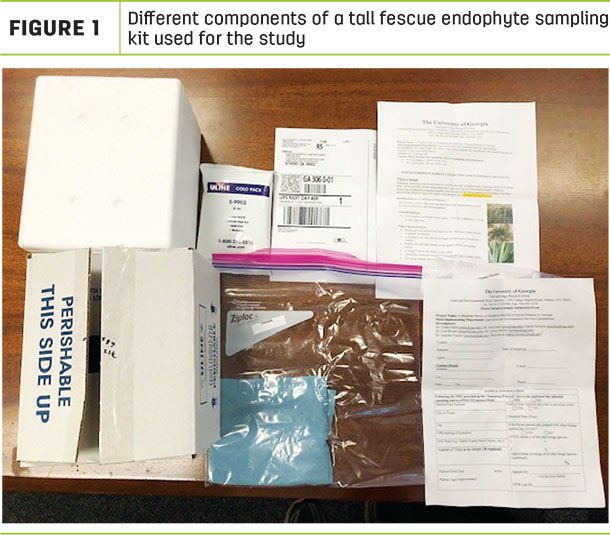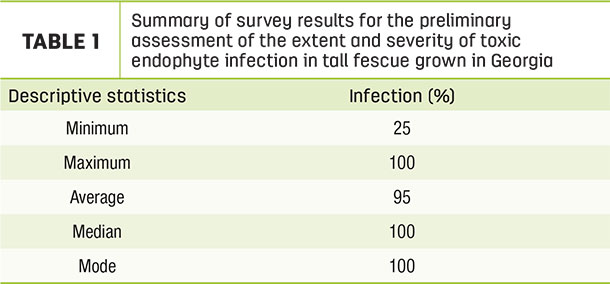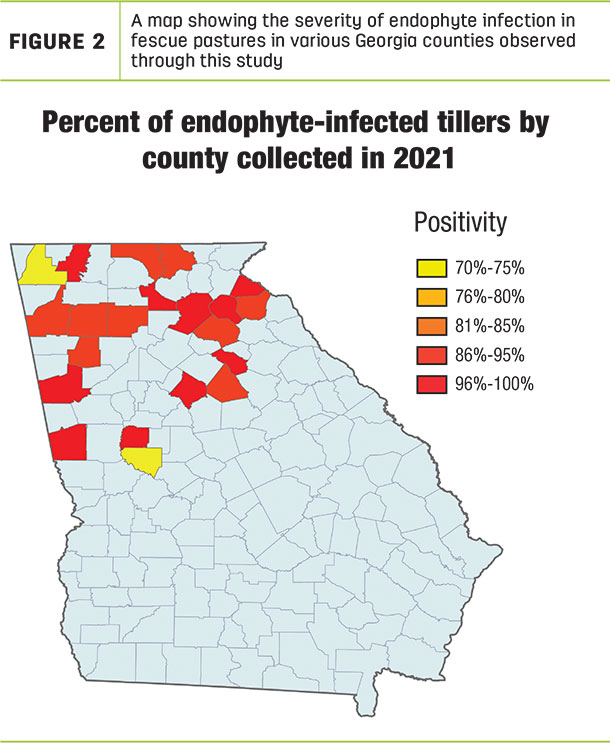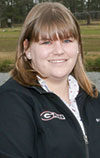Tall fescue, a cool-season perennial grass, grows on approximately 1 million acres in north Georgia and more than 30 million acres in the U.S. Cattle can graze on this grass for an extended period from early spring to fall.
Furthermore, stockpiling this grass in pastures and hay fields during late summer to early fall allows grazing during late fall to early winter, which can considerably reduce the fall and winter feed costs. However, the majority of these acres are infected with the fungus Neotyphodium coenophialum that grows inside the tall fescue plant and is transmitted via seed.
The endophyte confers several benefits to tall fescue such as drought and stress tolerance, insect and disease resistance, and grazing persistence. At the same time, the plant provides energy and a sustainable environment for the fungus. This beneficial symbiotic relationship between the plant and fungus is considered necessary to ensure optimal plant production and survival. However, the endophyte produces toxins called ergot alkaloids that cause “fescue toxicosis” and exert toxic effects in livestock which cost beef cattle farmers a billion dollars annually in lost revenue each year in the U.S. alone after livestock graze infected pastures or consume hays from infected fields.
Various adverse effects of fescue toxicosis on animals have been reported, including “summer syndrome,” “fescue foot,” reproductive difficulties, reduced weight gain, decreased milk production, slightly elevated body temperature, impaired heat tolerance, excessive nervousness and failure to shed winter hair coats in the spring.
Estimating the scope of toxic endophyte infection in tall fescue
It is expected that the vast majority of tall fescue in Georgia and other places in the U.S. is infected by the toxic endophyte, but there is a lack of clear and precise information about the nature and extent of endophyte infection in the tall fescue stands. To address this lack of information, we conducted a survey to assess the severity of toxic endophyte infection in tall fescue critical to the beef cattle industry in Georgia. This baseline survey was conducted with a grant funding from the Georgia Commodity Commission for Beef Cattle to have a preliminary assessment of the extent and severity of toxic endophyte infection in the 1 million acres of tall fescue in Georgia.
Samples were collected through collaborative efforts of the grant team and the ANR Extension agents of various counties. Emphasis was given to have samples collected as broadly as possible throughout the mountain and Upper Piedmont regions of Georgia (north of the 33-degree north parallel). As the goal of this project was to evaluate the nature and extent of toxic endophyte infection, all necessary measures were taken to exclude samples from the fields that are known to be novel endophyte varieties.
The project team developed a special sample submission form; an easy-to-follow, step-by-step sampling protocol; and an instructional video to ensure all samplers uniformly followed the recommended protocol. Sampling kits were provided to each extension agent to ensure uniformity in sample collections (Figure 1).

Full details on the methodology of this project and these resources may be found online (University of Georgia Agricultural and Environmental Services Laboratory).
We received and analyzed samples from 50 tall fescue fields in 21 Georgia counties. Endophyte analyses of the tiller samples were conducted using proprietary testing. All laboratory analyses were conducted by staff of the University of Georgia Agricultural and Environmental Services Laboratory in Athens, Georgia.
Final results
All 50 tall fescue fields sampled from 21 counties turned out to be severely infected by endophyte (Table 1).

Except for one sample from Walker County which had 70% infected tillers, and three from Upson County that had a mean infection level of 73%, the mean infection levels in the rest of the samples from 19 counties varied from 87% to 100%. The lowest infection of 25% was observed in a pasture from Upson County, but the other two pastures from this county had 95% and 100% infection. The mean infection level for the whole study was 94% with a median of 100%. Out of 56 samples tested, 30 had 100% infected tillers. Thus, we found endophyte infection in the tall fescue fields in Georgia is widespread and mostly severe. A color-coded map using the mean endophyte infection levels observed in the 21 counties is presented in Figure 2.

Where do we go from here?
In general, if a field has less than 20% to 35% endophyte infection, the toxins can be diluted by interseeding legumes (usually white clover or red clover). However, only one sample from Upson County with 25% endophyte infection would qualify for applying this recommendation. Renovation with tall fescue varieties that are infected with a novel endophyte that do not produce toxic ergot alkaloids is the best option for fields that have 60% or greater endophyte infection. Thus, all other 49 fields of this study, with 70% to 100% endophyte infection, merit renovation with newer novel endophyte tall fescue varieties. This replacement would be a costly investment initially, but this is going to be a cost-effective intervention for the tall fescue-based livestock systems in the long run, as found by the economists from the University of Georgia.
We also believe these baseline survey results will serve as a teaching tool to convince farmers to have their own pastures tested in order to assess the need for remedial management. Since NRCS offers cost-sharing for renovation of tall fescue pastures with novel endophyte varieties of fescue in Georgia, the impact of this survey results is much higher. Furthermore, the outcomes of this survey will help with the current work of the Alliance for Grassland Renewal. ![]()
Lisa Baxter is an assistant professor and state forage extension specialist with the department of crop and soil sciences at the University of Georgia. Abdolmajd Ronaghi is a research professional for the agricultural and environmental services laboratories at the University of Georgia. David Parks is the a laboratory manager at the agricultural and environmental services laboratories at the University of Georgia.
Uttam Saha is a senior public service associate and program coordinator at the agricultural and environmental services laboratories at the University of Georgia. Email Uttam Saha.











